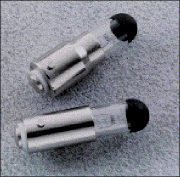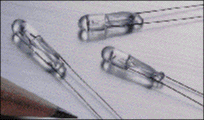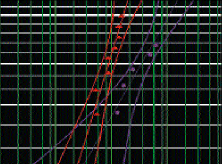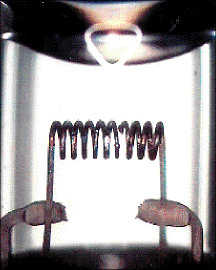Determining lamp life
Rated lamp life is affected by
several variables

BY DEAN BELL and DOUG RUTAN
Welch Allyn Lighting Products
Skaneateles Falls, NY
When specifying incandescent and arc lamps for lighting applications, determining their lamp life is critical. While most electronic-component specifications found in product catalogs are universal, such is not the case with the rated life of halogen, vacuum, gas-filled, and metal-halide lamps.

For example, a 15-W halogen lamp from one manufacturer might be rated for a significantly longer life than the same lamp from another manufacturer. Determining how these manufacturers specify lamp life can affect the performance of the end product.
Incandescent lamps
The most common method for testing incandescent lamps is to rack-test a number of lamps in a controlled environment at a constant voltage. The number of lamps used in the testing is determined by statistical sampling to ensure the required level of quality. What many specifiers and designers may not realize is that the lamp life ratings cited in catalogs can represent either a mean (average) or a median (middle number of a series), depending on lamp life expectancy.
Lamps rated at less than 1,000 hours are left on until all have burned out. Expected life is then calculated using the mean of the burn-out times. Lamps that are rated for more than 1,000 hours, however, are run until there are a significant number of failures (typically 50%) to calculate the median lamp life. The sample is taken when a predetermined number of lamps have failed.
The median can also be found using a Weibull Distribution (see Fig. 1 ), which is a more general form of an exponential distribution. The sample of data is taken and analyses performed when a specific number of lamps have failed.
Fig. 1. Incandescent and arc lamps use a Weibull Distribution–a
more general form of an exponential distribution of which the normal distribution
is a specific example–to determine the median lamp life measured in hours.
Arc lamps
Arc lamps are tested in the same manner as incandescent lamps–rack testing at a constant voltage under controlled laboratory conditions. During the testing, lamp failure is not evenly distributed over the time frame; a few lamps might fail quickly, while others might last significantly longer. As a result, arc lamp life is also calculated using a Weibull Distribution to determine median lamp life.
Arc lamps are typically tested using long duty cycles, which is appropriate for most high-intensity discharge lamps that are left on for extended periods of time. Smaller-wattage arc lamps, such as the Solarc lamp from Welch Allyn, are tested using shorter duty cycles. As a result, the lamp's rated life gives the user a closer approximation of actual lamp life.
Although accurate information can be obtained using these methods, several other factors–which are often not reflected in lamp life ratings–can affect actual lamp life:
Duty cycle . How often a lamp is turned on and off–its duty cycle–can put considerable stress on its filament because of in-rush current.
Burn position . Typically, lamps are tested in either a vertical or horizontal position. If the lamp's test position differs from the position of the lamp in actual use, realized lamp life can be affected.
Shock and vibration . The fragile nature of a halogen-lamp's filament also makes it sensitive to sudden shocks and certain vibrations. In actual use, lamps are frequently subjected to more shock than in a test environment, which can result in early failure. In addition, lamp filaments can also be extra-sensitive to certain frequencies and vibrations experienced during use, which can also lead to early lamp failure.
Voltage control . All lamps are designed to operate at a specified voltage. When an applied voltage differs from the design voltage, the realized lamp life will be different than specified. For example, operating at 10% above or below the specified applied voltage will cause lamp life to decrease or increase 50% to 65%.
Operating temperature and heat sinking . To operate correctly, halogen lamps typically must be at a specific temperature. Generally, this temperature is achieved when the interior wall of the envelope reaches 250°C. When a halogen lamp fails under optimal conditions, it is typically a result of center coil thinning (see Fig. 2 ).
Fig. 2. When a halogen lamp fails under optimal conditions,
it is typically caused by the center coil's thinning.
If halogen lamps run too cold–a common occurrence when lamps are severely heat sunk–maintenance decreases and the envelope darkens as a result of the chemistry not operating properly. In addition, if a lamp operates on a short duty cycle it may not achieve operating temperature, which can cause premature darkening. Gas-filled lamps, however, are not affected by operating temperature and can be used with severe heat sinking and short duty cycles.
Lamp degradation
A common misconception is that a lamp's end-of-life light output is the same as it was when the lamp was first turned on. In fact, a lamp's maintenance–that is, its ability to maintain its lumen output over its life–can decrease to a point at which it doesn't produce enough light output to perform its job effectively.
Applications that require the lamp to perform at a specified output at all times, such as spectrometers, must take into consideration the lamp life and maintenance to determine if the lamp will be effective over the entire rated life.
In addition to maintenance, the lamp's color temperature can shift over time. This can also affect the performance of a product that requires a specific color-temperature output.
Lamp manufacturers
A good manufacturer will explain the lamp life figures listed in its catalog. While many manufacturers are very optimistic when rating hours, others are conservative. Either way, lamps should meet the catalog rated life and all other specifications (such as maintenance, color, and temperature).
Also, lamps that are listed as having a longer life may indeed have a longer life, but may be unable to match other listed characteristics over the specified life. To help determine what lamp best suits an application, some manufacturers, such as Welch Allyn, offer the services of lamp application engineers to fully investigate the application, recommend appropriate test protocol, and ascertain the best lighting solution.
Advertisement







